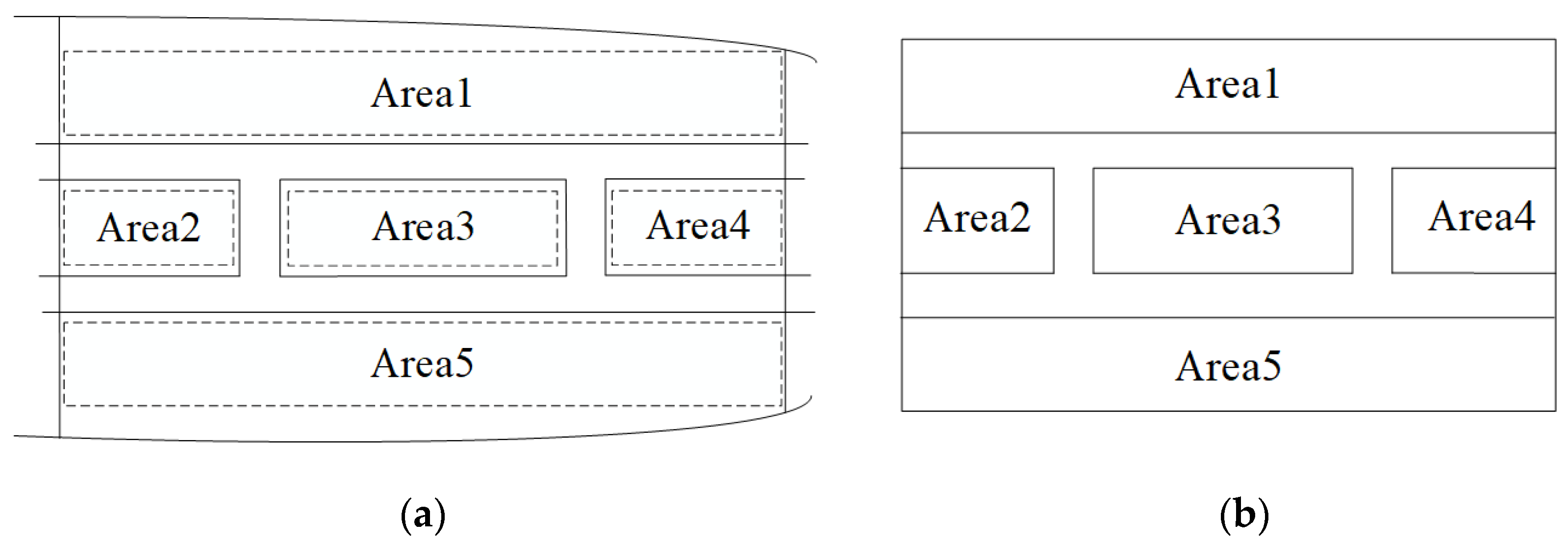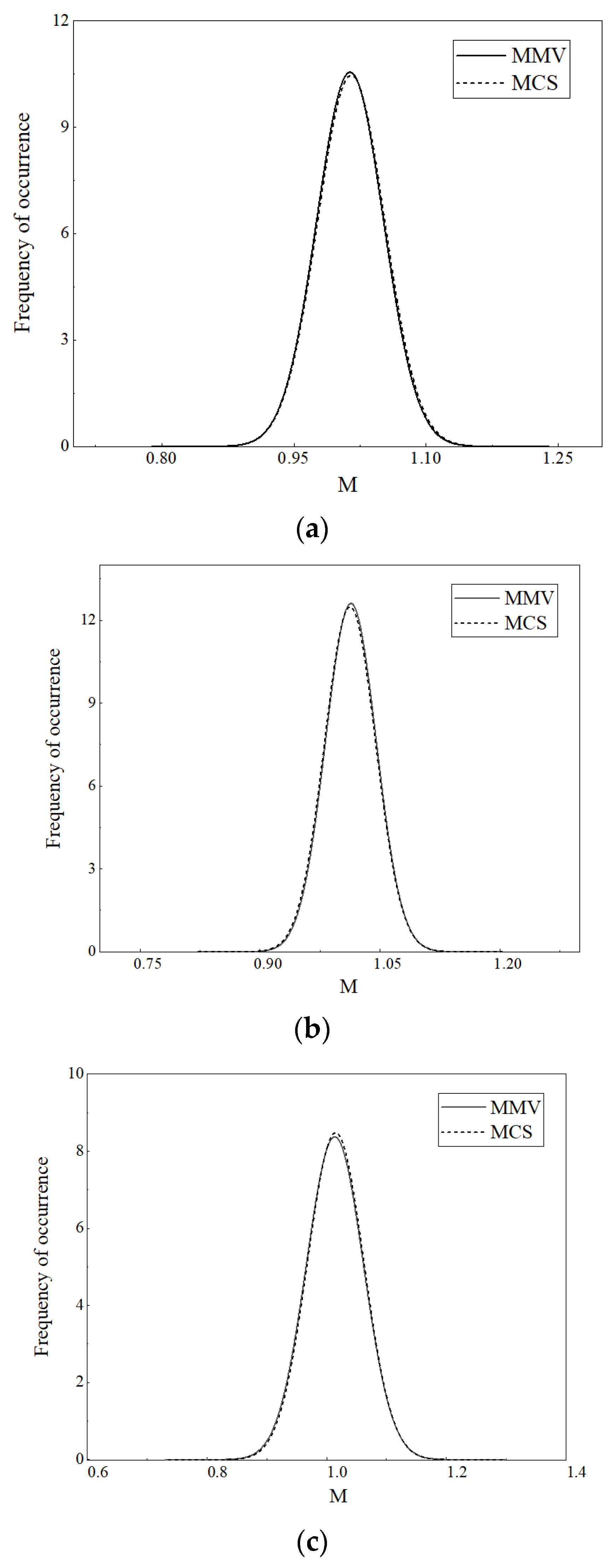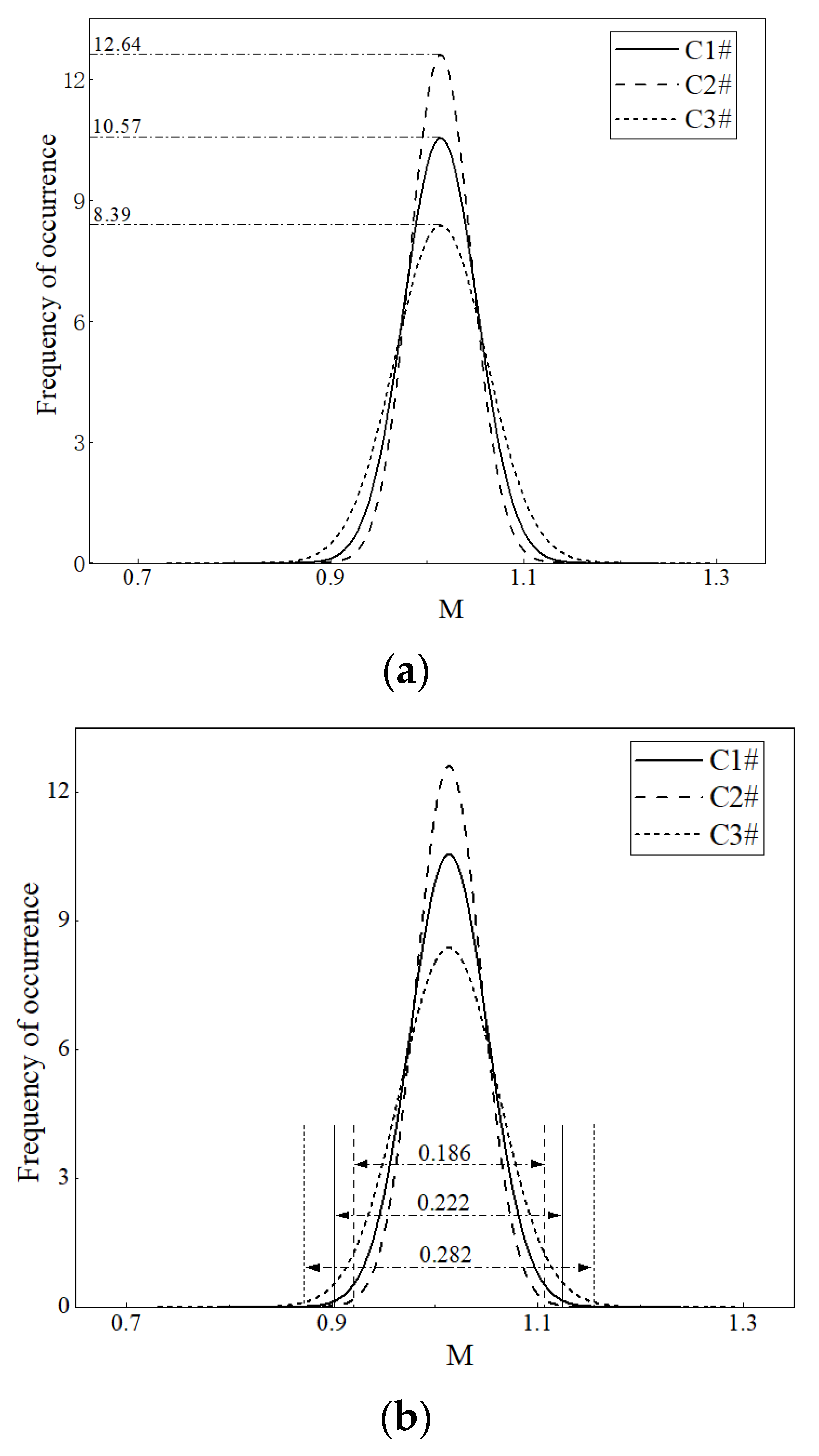Random/Cognitive Hybrid Uncertainty Analysis of Ship Multitasking Cabin Layout
Abstract
1. Introduction
2. Simplified Model and Deterministic Optimization Model of Cabin Layout
2.1. Definition of Multitasking States
2.2. Simplif
Simplified Layout Model
2.3. Deterministic Optimization Model
3. Uncertainty Parameters Analysis and Model Construction
3.1. Composition of Uncertainty Parameters
3.2. Random Variables
3.3. Interval Variables
3.4. Random-Interval Hybrid Uncertainty Model
3.5. Model Solving Methods
3.5.1. Random Intervalization Process
3.5.2. Interval Randomization Process
4. Robustness Analysis
4.1. Evaluation Indexes of Robustness Analysis
- (1)
- Reliability analysis mainly focuses on the influence of uncertain factors on design constraints. It analyzes the possibility of performance failure under potentially dangerous conditions.
- (2)
- Robustness analysis mainly focuses on the influence of uncertain factors on the objective function. It reduces the sensitivity of the scheme’s performance to external changes.
4.2. Calculation Cases
4.2.1. Input Parameters
4.2.2. Comparative Calculation Method
4.2.3. Comparative Calculation Results
4.2.4. Comparative Evaluation Indexes of Robustness Analysis
5. Conclusions
- (1)
- In the cabin layout design problem, the influence of uncertainty factors is considered, and the random-interval hybrid uncertainty model could fully consider the uncertainty of input parameters. In addition, it was able to ensure the robustness of the cabin layout scheme. The model dealt with parameters from two areas: probabilistic reliability theory and non-probabilistic reliability theory. It not only overcame the defect that the probability model was too dependent on the sample data, but it also reduced the blind conservatism of the non-probability model. It is of practical significance to apply this model to the layout design of ship cabins.
- (2)
- From the results of the robustness analysis, the robustness of the random variable group is the highest among the four cases of uncertain parameter schemes. Therefore, using random variables to describe artificially quantified parameters in the cabin layout optimization model can ensure the robustness of the optimization scheme to a greater extent. And it reduces the risk of uncertainty factors in the cabin layout design for multitasking states and better guarantees the efficiency of personnel and cargo circulation.
- (3)
- Compared with previous research by scholars, this paper expands the scope of cabin layout optimization from the single-task state to the multitasking state. And the uncertainty analysis of cabin layout optimization design is carried out. The advantages and disadvantages of different variables are explored. However, the variables are not designed in the optimization model. An uncertainty optimization platform can be established in the future. By comparing the solutions of the deterministic optimization and uncertainty optimization models, the advantages of uncertainty optimization are explored. At the same time, this paper also provides readers with new ideas. In future work on cabin layout optimization design, random variables can be considered to describe the artificially quantified parameters so as to improve the effectiveness of the cabin layout scheme.
Author Contributions
Funding
Institutional Review Board Statement
Informed Consent Statement
Data Availability Statement
Conflicts of Interest
References
- Benabes, J.; Poirson, E.; Bennis, F. Integrated and interactive method for solving layout optimization problems. Expert Syst. Appl. 2013, 40, 5796–5803. [Google Scholar] [CrossRef]
- Kim, K.-S.; Roh, M.-I. A submarine arrangement design program based on the expert system and the multistage optimization. Adv. Eng. Softw. 2016, 98, 97–111. [Google Scholar] [CrossRef]
- Bao, M.; Hou, Y.H.; Chen, W.; Wu, T.; Hu, Y.L. Joint optimization of ship cabin channel layout based on genetic algorithm. J. Dalian Marit. Univ. 2021, 47, 23–30. [Google Scholar] [CrossRef]
- Dong, Z.C.; Liu, Y.D. Optimization method of ship cabin layout based on reverse learning genetic algorithm. J. Dalian Marit. Univ. 2021, 47, 16–22. [Google Scholar] [CrossRef]
- Oberkampf, W.L.; Helton, J.C.; Joslyn, C.A.; Wojtkiewicz, S.F.; Ferson, S. Challenge problems: Uncertainty in system response given uncertain parameters. Reliab. Eng. Syst. Saf. 2004, 85, 11–19. [Google Scholar] [CrossRef]
- Wu, X.X. Research on solving strategy of structural reliability index based on probabilistic interval hybrid model. IOP Conf. Ser. Earth Environ. Sci. 2021, 791, 012113. [Google Scholar] [CrossRef]
- Hu, N.G.; Duan, B.Y. An efficient robust optimization method with random and interval uncertainties. Struct. Multidiscip. Optim. 2018, 58, 229–243. [Google Scholar] [CrossRef]
- Jiang, C.; Zheng, J.; Ni, B.Y.; Han, X. A probabilistic and interval hybrid reliability analysis method for structures with correlated uncertain parameters. Int. J. Comput. Methods 2015, 12, 1540006. [Google Scholar] [CrossRef]
- Baril, C.; Yacout, S.; Clément, B. Design for Six Sigma through collaborative multiobjective optimization. Comput. Ind. Eng. 2010, 60, 43–55. [Google Scholar] [CrossRef]
- Koch, P.N.; Yang, R.-J.; Gu, L. Design for six sigma through robust optimization. Struct. Multidiscip. Optim. 2004, 26, 235–248. [Google Scholar] [CrossRef]
- Kirtley, N. Fuzzy optimal general arrangements in naval surface ship design. Ship Technol. Res. 2009, 56, 121–141. [Google Scholar] [CrossRef]
- Wu, H.F. The shortest path algorithm-Dijkstra and Floyd algorithm. New China Commun. 2019, 21, 32–33. [Google Scholar]
- Rahayuda, I.G.S.; Santiari, N.P.L. Dijkstra and bidirectional dijkstra on determining evacuation routes. J. Phys. Conf. Ser. 2021, 1803, 012018. [Google Scholar] [CrossRef]
- Hua, L.; Wu, F.; Mou, J.L. Reliability analysis of yield strength of hull structure under random-non-probabilistic model. J. Natl. Univ. Def. Technol. 2018, 40, 177–182. [Google Scholar]
- Qiu, Z.P.; Wang, J. The interval estimation of reliability for probabilistic and non-probabilistic hybrid structural system. Eng. Fail. Anal. 2010, 17, 1142–1154. [Google Scholar] [CrossRef]




| Task States | Main Tasks |
|---|---|
| The damage state of fixtures and machines | Repair and replace damaged instruments or equipment |
| The escape state during danger | Ensure the smooth evacuation of all personnel to the upper deck |
| The maintenance and support state | Auxiliary ship repair and maintenance work |
| The daily navigation state | Ensure the normal operation of ship equipment and the normal development of crew work during sea navigation. |
| Cabin Groups | Mean Value | Standard Deviation | Coefficient of Variation | |
|---|---|---|---|---|
| The coefficient of adjacent strength | (1, 7) | 0.4 | 0.057 | The mean value of variation coefficient of interval variables 0.1425 |
| (9, 15) | 0.6 | 0.0855 | ||
| (17, 27) | 0.3 | 0.0428 | ||
| (33, 46) | 1 | 0.1425 | ||
| (77, 78) | 0.5 | 0.0713 | ||
| The coefficient of circulating strength | (1, 4) | 0.6 | 0.0855 | The mean value of variation coefficient of interval variables 0.1425 |
| (13, 31) | 1 | 0.1425 | ||
| (27, 67) | 0.5 | 0.0713 | ||
| (70, 80) | 0.4 | 0.057 | ||
| (72, 73) | 0.2 | 0.0285 |
| Cabin Groups | Endpoint Values | Coefficient of Variation | |
|---|---|---|---|
| The coefficient of adjacent strength | (2, 11) | (0.427, 0.727) | 0.1501 |
| (35, 39) | (0.29, 0.49) | 0.148 | |
| (56, 60) | (0.414, 0.514) | 0.062 | |
| (66, 79) | (0.555, 1) | 0.165 | |
| The coefficient of circulating strength | (9, 10) | (0.683, 0.783) | 0.039 |
| (41, 46) | (0.48, 0.98) | 0.1977 | |
| (44, 55) | (0.39, 0.59) | 0.1178 | |
| (50, 60) | (0.366, 0.966) | 0.260 |
| Cabin Groups | Endpoint Values | Coefficient of Variation | |
|---|---|---|---|
| The coefficient of adjacent strength | (1, 7) | (0.229, 0.571) | 0.2468 |
| (9, 15) | (0.344, 0.857) | 0.2468 | |
| (17, 27) | (0.172, 0.428) | 0.2468 | |
| (33, 46) | (0.999, 1.000) | 0.0001 | |
| (77, 78) | (0.286, 0.714) | 0.2468 | |
| The coefficient of circulating strength | (1, 4) | (0.344, 0.857) | 0.2468 |
| (13, 31) | (0.999, 1.000) | 0.0001 | |
| (27, 67) | (0.286, 0.714) | 0.2468 | |
| (70, 80) | (0.229, 0.571) | 0.2468 | |
| (72, 73) | (0.115, 0.286) | 0.2468 |
| Cabin Groups | Mean Value | Standard Deviation | Coefficient of Variation | |
|---|---|---|---|---|
| The coefficient of adjacent strength | (2, 11) | 0.577 | 0.005 | 0.0867 |
| (35, 39) | 0.39 | 0.0333 | 0.0854 | |
| (56, 60) | 0.464 | 0.0167 | 0.0359 | |
| (66, 79) | 0.7775 | 0.0733 | 0.0943 | |
| The coefficient of circulating strength | (9, 10) | 0.733 | 0.0167 | 0.0227 |
| (41, 46) | 0.73 | 0.0833 | 0.1142 | |
| (44, 55) | 0.0333 | 0.0333 | 0.068 | |
| (50, 60) | 0.666 | 0.1 | 0.1502 |
| Case | Input Parameters | Mean Value | Standard Deviation |
|---|---|---|---|
| C1# | 1.014 | 0.037 | |
| C2# | 1.014 | 0.031 | |
| C3# | 1.014 | 0.047 |
Disclaimer/Publisher’s Note: The statements, opinions and data contained in all publications are solely those of the individual author(s) and contributor(s) and not of MDPI and/or the editor(s). MDPI and/or the editor(s) disclaim responsibility for any injury to people or property resulting from any ideas, methods, instructions or products referred to in the content. |
© 2024 by the authors. Licensee MDPI, Basel, Switzerland. This article is an open access article distributed under the terms and conditions of the Creative Commons Attribution (CC BY) license (https://creativecommons.org/licenses/by/4.0/).
Share and Cite
Xu, H.; Hou, Y.; Li, H.; Bao, M.; Liu, H. Random/Cognitive Hybrid Uncertainty Analysis of Ship Multitasking Cabin Layout. J. Mar. Sci. Eng. 2024, 12, 120. https://doi.org/10.3390/jmse12010120
Xu H, Hou Y, Li H, Bao M, Liu H. Random/Cognitive Hybrid Uncertainty Analysis of Ship Multitasking Cabin Layout. Journal of Marine Science and Engineering. 2024; 12(1):120. https://doi.org/10.3390/jmse12010120
Chicago/Turabian StyleXu, Haijun, Yuanhang Hou, Haonan Li, Meng Bao, and Haishang Liu. 2024. "Random/Cognitive Hybrid Uncertainty Analysis of Ship Multitasking Cabin Layout" Journal of Marine Science and Engineering 12, no. 1: 120. https://doi.org/10.3390/jmse12010120
APA StyleXu, H., Hou, Y., Li, H., Bao, M., & Liu, H. (2024). Random/Cognitive Hybrid Uncertainty Analysis of Ship Multitasking Cabin Layout. Journal of Marine Science and Engineering, 12(1), 120. https://doi.org/10.3390/jmse12010120





